Weedom1 Does a Shroom
A Big Edible One
By popular demand, it’s time to take on the first wild mushroom, and this one is considered a fairly easy one by foragers and mycologists. In other words, there are no extremely toxic look-a-likes that can cause death, and they have good distinguishing characteristics.
One of the tulip poplars of weedom, which had become carpenter ant infested, was reduced to a stump. As with all our stumps, we left it to nature rather than spending money or effort to grind it out. A bit later we noticed that the stump was supporting new life, the fruiting bodies of which appeared sporadically at various times of year: November, February, June, August, whenever it felt the urge. The mighty Pleurotis mycelium, the oyster mushroom, had taken possession of the tulip poplar stump. During the first appearances, there was too much preoccupation with health care and various family events to pay much attention, though some pics of this curiosity were taken. But as the flushes of fruiting bodies bacame larger, it was impossible to ignore any longer, and thoughts of eating them were entertained. Often the surprise appearances would be noticed too late, but on a beautiful morning in June last year, the oysters looked perfect, and plentiful, though a little damp. After waiting a few hours for the dew to dry a bit, we harvested well over 3 lbs of them.
It was oyster-mania for the next week as we dried half of the mushrooms, and cooked up the other half of these things, and ate the mild flavored, chewy fungus. Thus we became very positive that these ‘oysters’ are excellent food, and wanted more. This year we’re going to try to plant more stumps with this fungus.
Though most mushroom toxicity involves memorable to severe gastro-intestinal distress, there are a some types mushrooms which can cause you to see things that aren’t there, while a very few other species can cause liver and kidney toxicity and death even from small doses. This has instilled quite a bit of fear in many people who might otherwise enjoy a bountiful and beneficial wild fungal harvest. The relative number of hospitalizations from mushroom poisonings is fairly small, (and has been dwarfed by adverse health care effects). So if you follow some fairly basic precautions, and learn to avoid some Amanitas and little brown mushrooms, the wild fungi can safely become part of your diet.
Most people are aware of the mushroom craze touting the nootropic and immune enhancing compounds found in many species, and good money is being paid for various teas and powders in an effort to obtain such benefits. At the very least, mushrooms provide good minerals, complex carbohydrates, proteins, a great source of vitamin D precursor (ergosterol), all in a delicious, low calorie form. It makes sense to learn how to find this tremendous nutrition for free, and learning the oyster mushrooms is a good way to start your journey.
Oyster mushrooms belong to the Kingdom of Fungi, Phylum- Basidiomycota, Class- Agaricomycetes, Order- Agaricales, Family -Pleurotaceae, Genus- Pleurotus. There is a good deal of argument as to how many species are within the pleurotus genus, (at least 40 and perhaps many more), and the means of classification is in flux. The name Pleurotus suggests ‘side ear’ which refers to the main part of the fruiting body emerging from the side of a stipe, or stem, which is attached laterally to a substrate, which is usually a piece of wood, trunk or stump. Oyster mushrooms can occur singly or in large ruffly groups of gilled caps. The gills have smooth edges, and extend at least partially down the short stem or stipe in a manner described as decurrent. Notice that the stems are always off center, and usually the cap extends assymetrically and never 360 degrees around the stem. The stipe of this mushroom, which is normally fairly short, has no veil or ring, in the case of those found at weedom.
A main way to assist in the identification of a fungus is to place the caps onto a piece of paper and tap them to obtain a spore print. The spores of P. ostreatus and P. pulmonarius will show as light lilac to white in color. When freshly picked, these mushrooms give off a mild anise odor which fades after awhile. Some Pleurotus species elicit an almond odor. Our oyster mushroom caps are often white or grayish white when produced in warmer weather. In cooler weather the fruiting bodies are a more brownish shade. In recent years of mild weather we have been seeing these shrooms flushing at variable times between February and November.
Sometimes the mushrooms appear to grow out of the ground, but they’re actually emerging from the root of a tree. Pleurotus species specifically grow on wood in the wild.
At weedom, we’re not too worried exactly which of 2 species of ‘oysters’ we’re pulling off of the stumps. Formerly they, and several other oyster mushrooms, were lumped together as P. ostreatus, and in the 90s, they were split and renamed as seperate species. The most common story among mycologists and foragers lately is that Pleurotis ostreatus flushes in cooler weather, and Pleurotis pulmonarius flushes in the summer to early fall, and that this is the main differentiating characteristic. Both species are extremely popular and tasty to foragers. P. ostreatus, however, is big food business, and cultured worldwide, perhaps because it tastes great, and seems to flush readily at optimal temperatures between about 50 degrees and 70 degrees F. (10-20 C.) which is easier for controlling the competing organisms than warmer temps would be.
Another oyster is called Pleurotis populinus, because it grows almost exclusively on poplars, such as aspen and cottonwood trees. (Our tulip poplar (Liriodendron tulipfera) is actually a type of magnolia, so it doesn’t qualify.) P. populinus appears from spring to fall, and is more abundant in western and in mountainous regions of the U.S. where these trees abound. The fourth, perhaps less common oyster that shares the softer hardwoods with P. ostreatus, is Pleurotis dryinus, the veiled oyster. This one is more unique among the its genus, because it has a ring on the stem, which remains after the cap opens up. The gills under the cap stop at the point of this stem ring. Check this older site, while it lasts, for pictures of various common species of oyster mushrooms. .
Lastly (to prevent information overload) we’ll cover the now controversial angel wing mushroom, which until the turn of the century was fairly popular Japanese food. This mushroom used to be a Pleurotis, but now it’s been reassigned to a genus of it’s very own, Pleurocybella … porrigens to be exact. People have been eating this smaller, delicate oyster mushroom with very thin caps for many years. In the early 2000s, it was associated with a rash of extremely adverse events among elderly Japanese people with kidney failure. There have been perhaps a dozen and a half deaths reported among people in Japan who were on kidney dialysis, with another 40 people suffering severe poisoning. So we therefore conclude that dietary use of this mushroom is not a good idea for those with extremely impaired to no kidney function, and that there’s 1 or more non-dialyzable toxins in this mushroom which most people readily eliminate through functional kidneys. Now you know who should not try to eat angel wing mushrooms. Additionally, this small, delicate species grows on the logs of conifer trees (pines, spruces, etc.) almost exclusively. It is more sessile than the Pleurotus oyster mushrooms, growing straight out of the wood with little or no sign of a stem.
You can’t escape weedom without a bit of chemistry, though. The tenacious Japanese researchers spent about 2 decades trying to figure out what caused the poisoning and encephalopathy symptoms in this group of 59 people with end stage renal disease. More recently a reasonable theory has been put forth that a number of compounds in the mushroom contributed to the toxicity. Research suggests that 2 compounds pleurocybelline and Pleurocybella-lectin form a complex that disrupts the blood brain barrier. This allows a 3rd compound, pleurocybellaziridine, to get past the protective wall of the brain (blood-brain barrier) and kills the cells which make up the myelin sheath of nerve cell axons. Seizures and brain damage ensue.
We ponder the tremendous job that our kidneys and liver do in allowing us to taste many delicacies, and enjoy nutritious, delicious food, and are grateful to them.
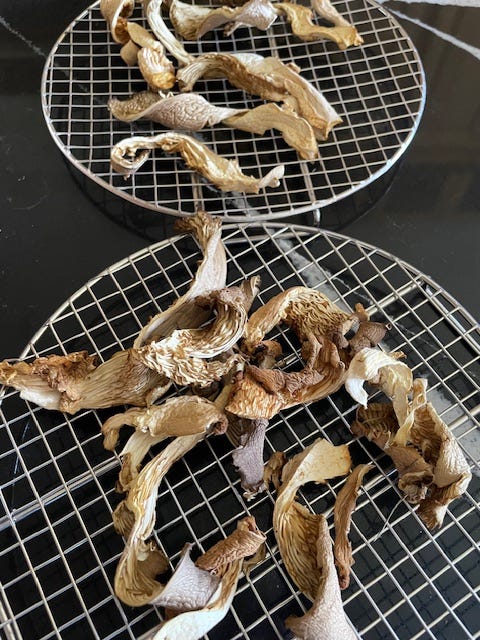
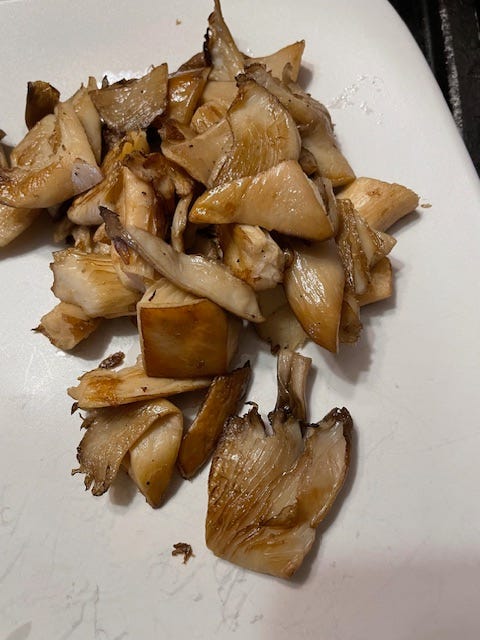
When introducing yourself to the amazing wild mushrooms, we recommend a lot of looking and research before you start eating, even though the extremely dangerous ones are rare. Still, getting a severely upset gastrointestinal tract is no fun at all. Start by learning the main classes of ‘shrooms to avoid, such as the amanita group and the non-descript little brown mushrooms that require long expertise to differentiate. Make friends with a local person who has survived their own mushroom foraging if you have any doubts about your own abilities to study and identify these fungi. Cook your chosen wild fungus before eating it, and try a small amount before you go all in. This can save you from disasters that could be due your own physiological uniqueness and tolerance to the mushroom.
Rest assured that before any wild fungi of weedom are presented as edible, it’s because we’ve been eating them, and are still kicking :-D
Where We Dig
1. Deepalakshmi K, Mirunalini S. Pleurotus ostreatus: an oyster mushroom with nutritional and medicinal properties. Published online 2014.
2. Pleurotus ostreatus, the Oyster mushroom, Tom Volk’s Fungus of the Month for October 1998. Accessed March 19, 2025. https://botit.botany.wisc.edu/toms_fungi/oct98.html
3. Phoenix Oyster Mushrooms: Identification and Foraging - Mushroom Appreciation. July 26, 2022. Accessed March 19, 2025. https://www.mushroom-appreciation.com/phoenix-oyster-mushrooms.html
4. (PDF) Nutritional and medicinal benefits of Oyster (Pleurotus) mushrooms: a review. ResearchGate. Published online December 16, 2024. doi:10.5943/FunBiotec/1/2/5
5. Oyster Mushroom: Identification, Foraging, and Cooking - Mushroom Appreciation. February 24, 2022. Accessed March 19, 2025. https://www.mushroom-appreciation.com/oyster-mushroom.html
6. Dicks L, Jakobs L, Sari M, et al. Fortifying a meal with oyster mushroom powder beneficially affects postprandial glucagon-like peptide-1, non-esterified free fatty acids and hunger sensation in adults with impaired glucose tolerance: a double-blind randomized controlled crossover trial. Eur J Nutr. 2022;61(2):687-701. doi:10.1007/s00394-021-02674-1
7. Samavi A, Mahmood RT, Hussain MA, et al. EXTRACTION AND ANALYSIS OF SECONDARY METABOLITES FROM PLEUROTUS OSTREATUS FOR ITS BIOMEDICAL APPLICATIONS. 2024;20(04).
8. Kikuchi T. Ergostane-type steroids from mushrooms of Pleurotus genus. J Nat Med. 2025;79(2):289-302. doi:10.1007/s11418-024-01872-5
9. Dicks L, Ellinger S. Effect of the Intake of Oyster Mushrooms (Pleurotus ostreatus) on Cardiometabolic Parameters-A Systematic Review of Clinical Trials. Nutrients. 2020;12(4):1134. doi:10.3390/nu12041134
10. KAWAGISHI H. Chemical elucidation of acute encephalopathy by ingestion of angel-wing mushroom (Pleurocybella porrigens) — involvement of three constituents in onset —. Proc Jpn Acad Ser B Phys Biol Sci. 2023;99(7):191-197. doi:10.2183/pjab.99.012
11. Hadar Y, Cohen-Arazi E. Chemical Composition of the Edible Mushroom Pleurotus ostreatus Produced by Fermentation. Appl Environ Microbiol. 1986;51(6):1352-1354. doi:10.1128/aem.51.6.1352-1354.1986
12. Aspen Oyster Mushroom: Identification and Foraging - Mushroom Appreciation. August 9, 2022. Accessed March 19, 2025. https://www.mushroom-appreciation.com/aspen-oyster-mushroom.html
13. Kuwabara T, Arai A, Honma N, Nishizawa M. [Acute encephalopathy among patients with renal dysfunction after ingestion of “sugihiratake”, angel’s wing mushroom--study on the incipient cases in the northern area of Niigata Prefecture]. Rinsho Shinkeigaku. 2005;45(3):239-245.



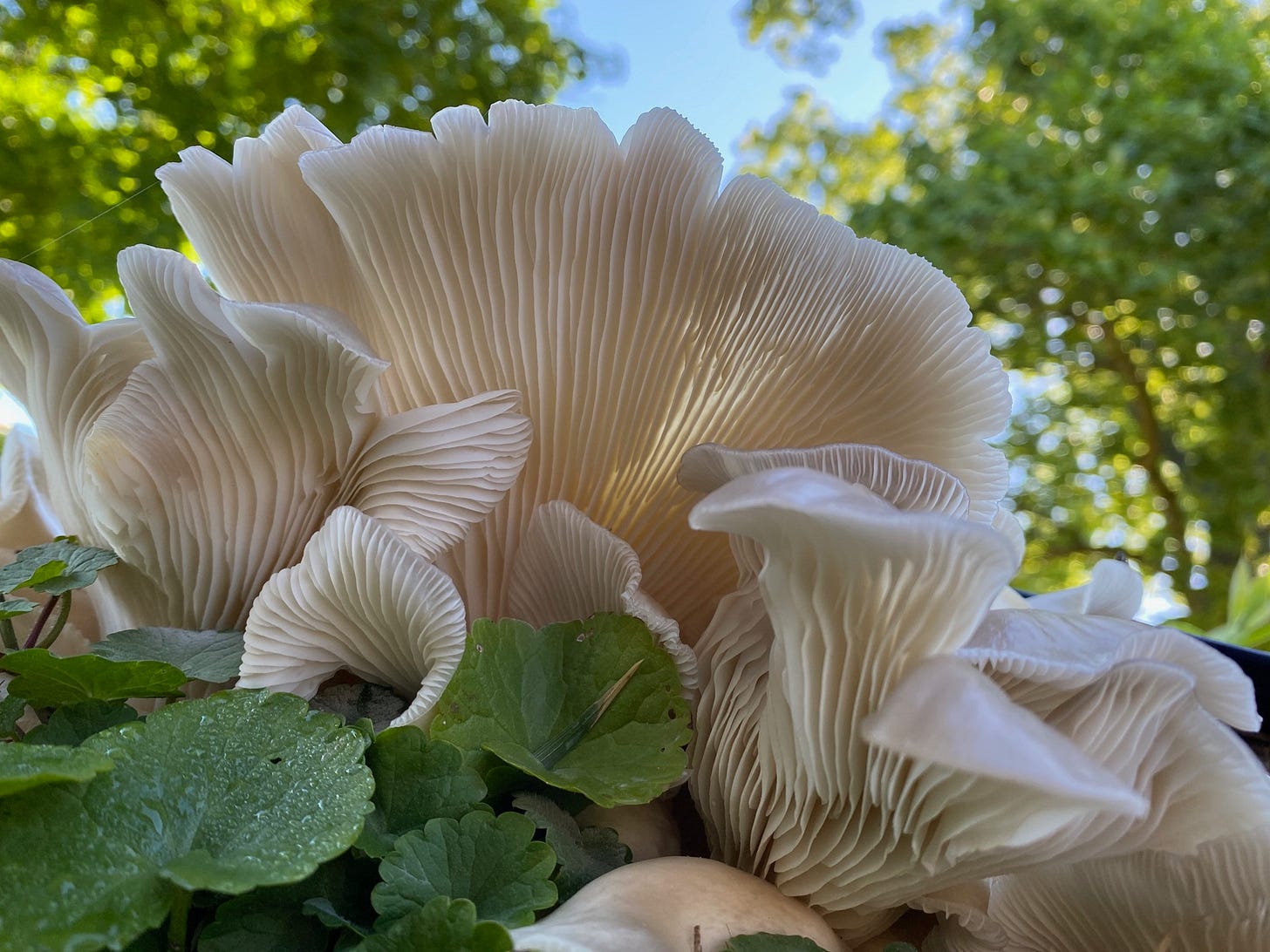
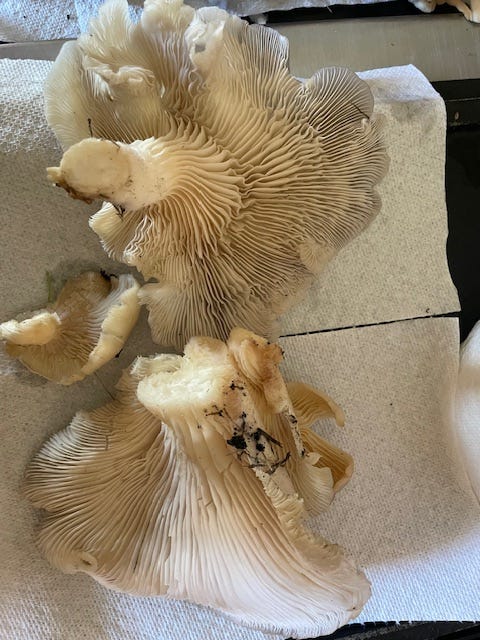
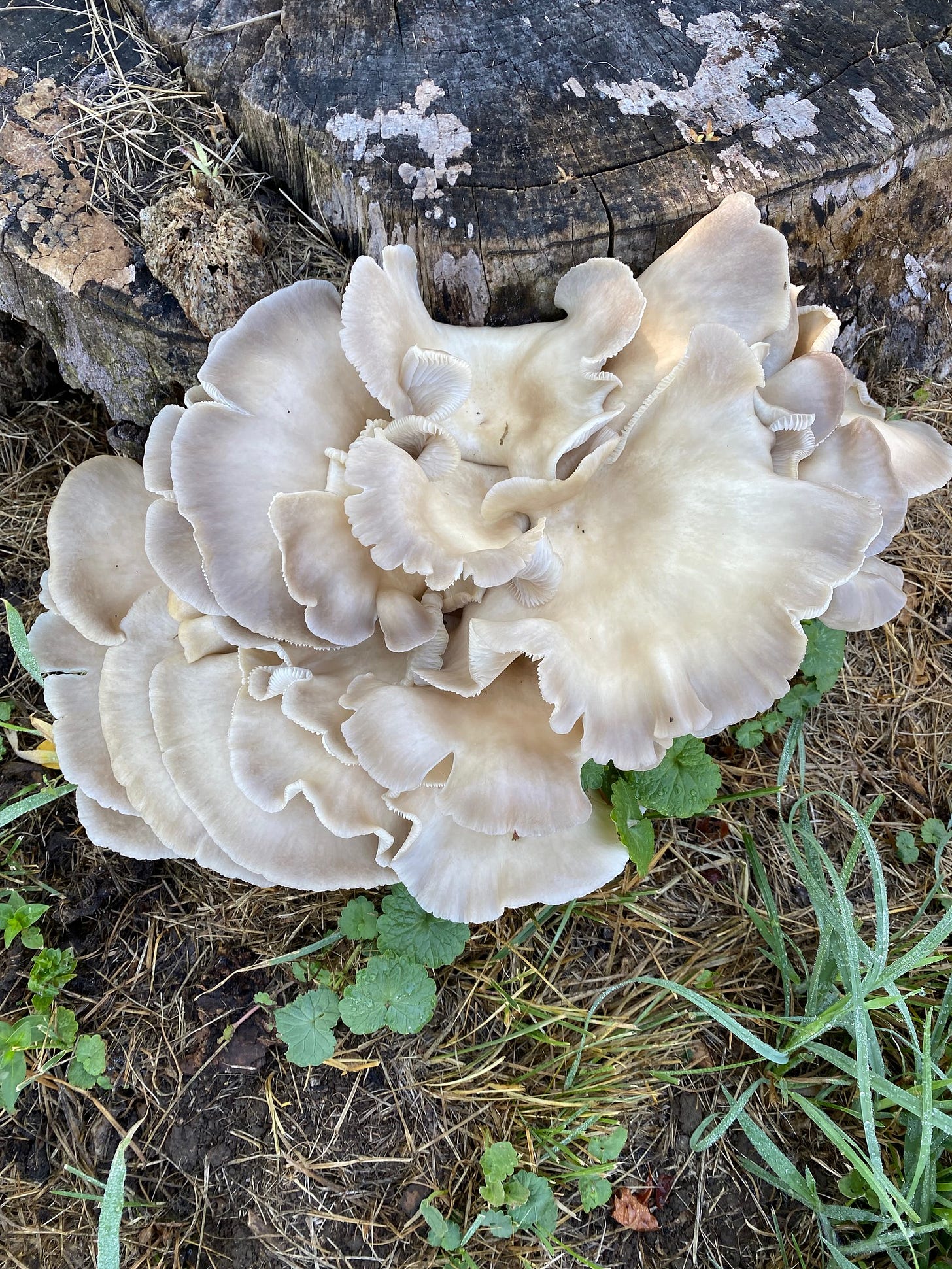
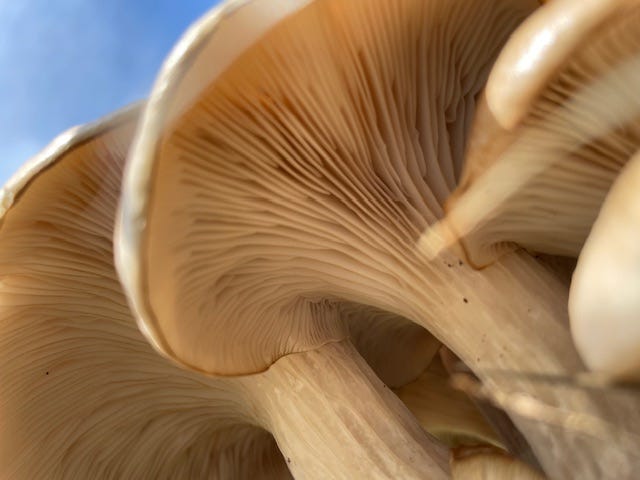
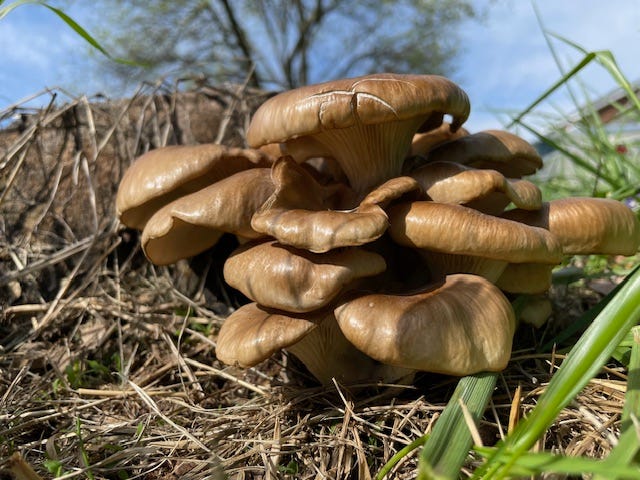
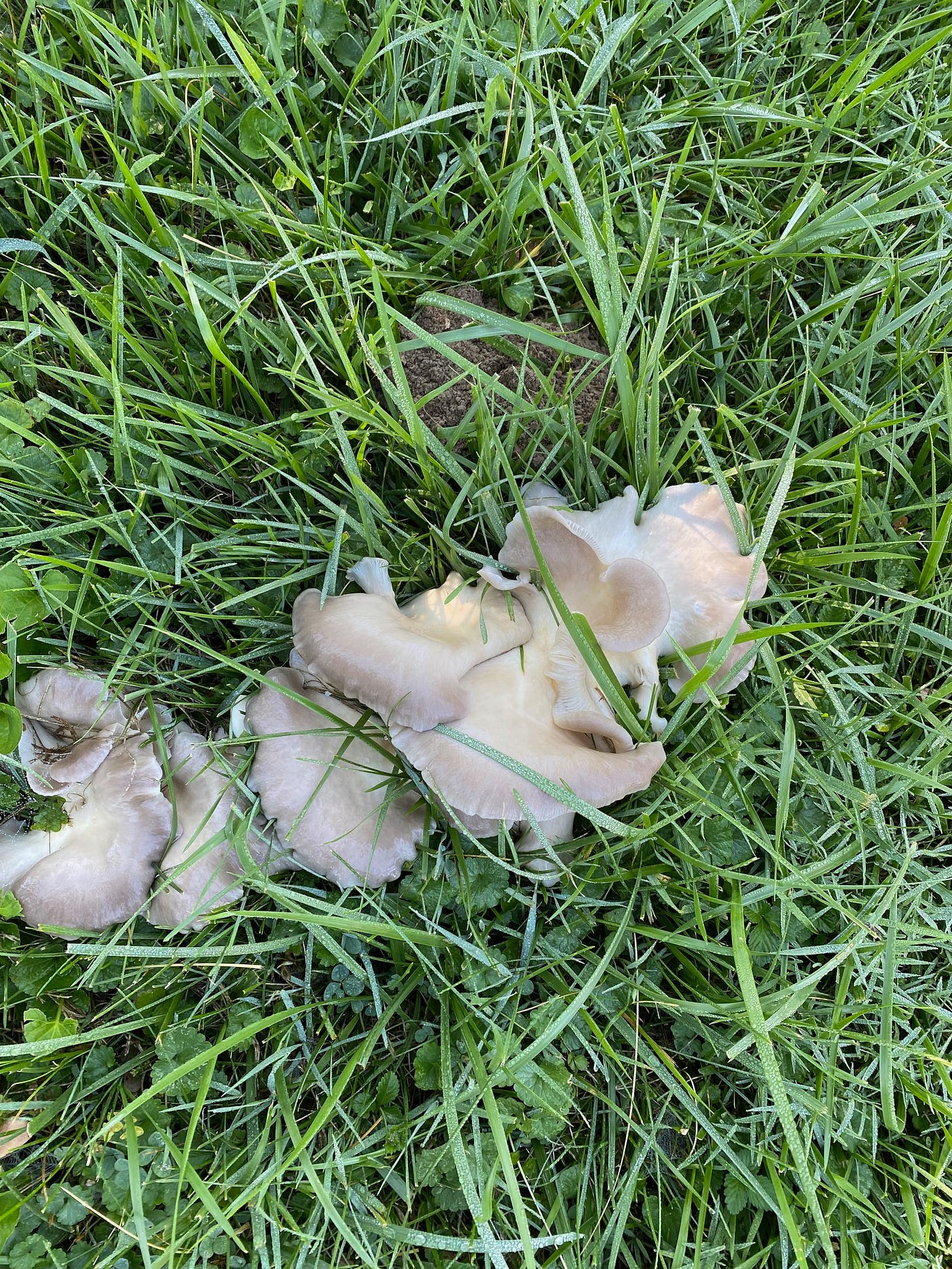

Found these last year in our back yard!